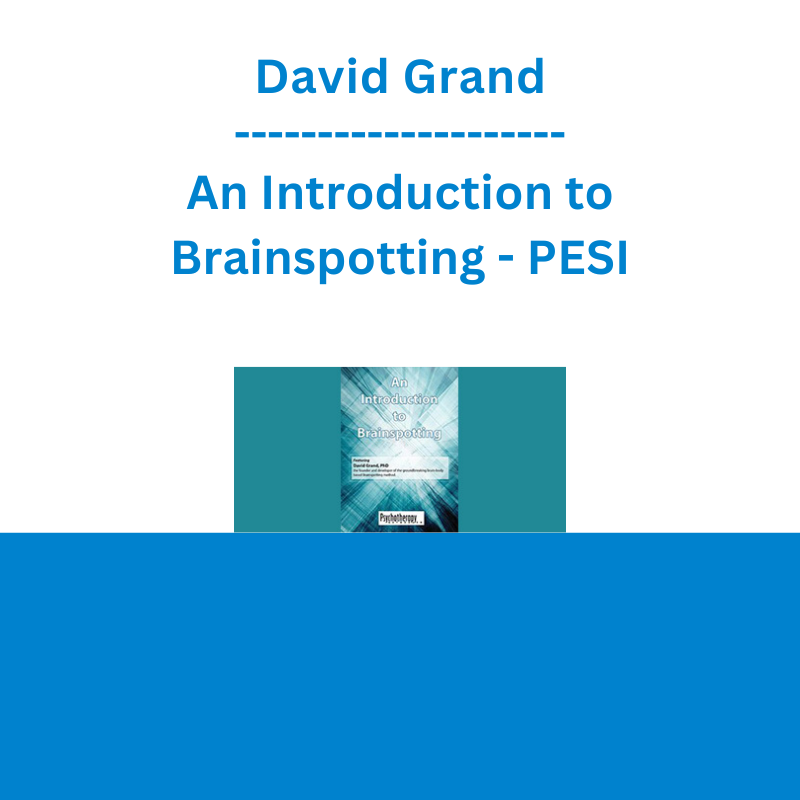*** Proof of Product ***
Exploring the Essential Features of “David Grand – An Introduction to Brainspotting – PESI”
Speaker: David Grand, PhD
Duration: 3 Hours 50 Minutes
Format: Audio and Video
Copyright: Mar 25, 2017
Media Type: Digital Seminar
Description
Symptoms of unprocessed trauma—including dissociation, numbing, and chronic anxiety—are notoriously difficult to eliminate through talk therapy. The reason: the overwhelmed brain is unable to process verbal information about the events. But Brainspotting, a brain-based method for clearing trauma blockage without clients having to talk about it, nurtures the capacity for natural self-healing.
Speaker
David Grand, PhD
David Grand, PhD, is a psychotherapist, writer, lecturer, performance coach, and humanitarian famous for the discovery and development of the internationally acclaimed Brainspotting method, which brings about life-changing breakthroughs at “Warp Speed.” Dr. Grand is a Licensed Clinical Social Worker with a PhD from International University, and is renowned for his groundbreaking discoveries and advancements in the arenas of healing trauma and enhancing performance and creativity. His Brainspotting method and BioLateral Sound are now used by thousands of therapist on every continent seeking to break through the limitations of talk therapy. Dr. Grand is the author of Brainspotting: The Revolutionary New Therapy for Rapid and Effective Change.
Speaker Disclosures:
Financial: David Grand maintains a private practice. He is the developer of the Brainspotting method. Dr. Grand receives a speaking honorarium from PESI, Inc. He has no relevant financial relationships with ineligible organizations.
Non-financial: David Grand has no relevant non-financial relationship to disclose.
Objectives
- Illustrate specific eye movements, including wobbles and microsaccades, as well as other facial cues and reflexes that reveal specific “spots” in the brain associated with the activation of trauma
- Instruct traumatized clients how to attend to their inner experience as they move through dissociative blocks and maximize a process of self-healing
- Explore skills that allow you to pay attention to your interactions with clients while also staying attuned to the internal brain changes reflected in their eye movements
- Implement Brainspotting to address a number of issues including anxiety and panic
Outline
Introduction
- Brainspotting as an Integrated & Relational Model
- Brainspotting & Eye Positions
Research
- Newton-Sandy Hook Community Foundation, Inc. Survey
- Study of the Efficacy of Brainspotting
- Brainspotting: A Neurobiological Hypothesis
- Training
Brainspotting Trauma & Dissociation
- Background Summary of Brainspotting
- Trauma & Dissociation
- Identifying Brainspotting
- Outside Window
- Inside Window
- Gaze=spotting
- What is a Brainspot?
- What is Interpersonal Neurobiology?
The Brainspotting Model
- Assessment History
- The Dual Attunement Frame
- 2 Models of Brainspotting
- Activation Model
- Resource Model
- Moving Client’s From Dysregulation to Regulation
- Regulation Brain Structures & Treatment Sequence
Core Principle & Clinical Application of Brainspotting
- The Uncertainty Principle
- Treatment Sequence
- Client Psychoeducation
- Q& A
- Work with Veterans
- EMDR vs. Brainspotting
- EFT vs. Brainspotting
Parts Approach
- Beginning
- Activation
- Suds
- Location of Body Activation/Somatic Awareness
- Eye position
- Focused mindfulness
- Return to Beginning/Re-evaluating Suds
Live Demonstration of Brainspotting
Target Audience
- Psychologists
- Physicians
- Addiction Counselors
- Counselors
- Social Workers
- Marriage & Family Therapists
- Nurses
- Other Behavioral Health Professionals
Please see the full list of alternative group-buy courses available here: https://lunacourse.com/shop/










 Julie Stoian & Cathy Olson - Launch Gorgeous - Funnel Gorgeous Bundle
Julie Stoian & Cathy Olson - Launch Gorgeous - Funnel Gorgeous Bundle  Racing Workshop - Complete Online Package
Racing Workshop - Complete Online Package  Team NFT Money - Ultimate NFT Playbook
Team NFT Money - Ultimate NFT Playbook  Money Miracle - George Angell - Use Other Peoples Money To Make You Rich
Money Miracle - George Angell - Use Other Peoples Money To Make You Rich